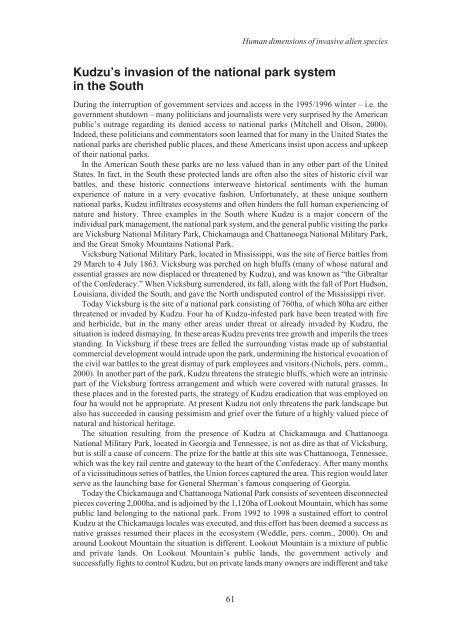Alien Species.vp - IUCN
Alien Species.vp - IUCN
Alien Species.vp - IUCN
You also want an ePaper? Increase the reach of your titles
YUMPU automatically turns print PDFs into web optimized ePapers that Google loves.
Kudzu’s invasion of the national park system<br />
in the South<br />
During the interruption of government services and access in the 1995/1996 winter – i.e. the<br />
government shutdown – many politicians and journalists were very surprised by the American<br />
public’s outrage regarding its denied access to national parks (Mitchell and Olson, 2000).<br />
Indeed, these politicians and commentators soon learned that for many in the United States the<br />
national parks are cherished public places, and these Americans insist upon access and upkeep<br />
of their national parks.<br />
In the American South these parks are no less valued than in any other part of the United<br />
States. In fact, in the South these protected lands are often also the sites of historic civil war<br />
battles, and these historic connections interweave historical sentiments with the human<br />
experience of nature in a very evocative fashion. Unfortunately, at these unique southern<br />
national parks, Kudzu infiltrates ecosystems and often hinders the full human experiencing of<br />
nature and history. Three examples in the South where Kudzu is a major concern of the<br />
individual park management, the national park system, and the general public visiting the parks<br />
are Vicksburg National Military Park, Chickamauga and Chattanooga National Military Park,<br />
and the Great Smoky Mountains National Park.<br />
Vicksburg National Military Park, located in Mississippi, was the site of fierce battles from<br />
29 March to 4 July 1863. Vicksburg was perched on high bluffs (many of whose natural and<br />
essential grasses are now displaced or threatened by Kudzu), and was known as “the Gibraltar<br />
of the Confederacy.” When Vicksburg surrendered, its fall, along with the fall of Port Hudson,<br />
Louisiana, divided the South, and gave the North undisputed control of the Mississippi river.<br />
Today Vicksburg is the site of a national park consisting of 760ha, of which 80ha are either<br />
threatened or invaded by Kudzu. Four ha of Kudzu-infested park have been treated with fire<br />
and herbicide, but in the many other areas under threat or already invaded by Kudzu, the<br />
situation is indeed dismaying. In these areas Kudzu prevents tree growth and imperils the trees<br />
standing. In Vicksburg if these trees are felled the surrounding vistas made up of substantial<br />
commercial development would intrude upon the park, undermining the historical evocation of<br />
the civil war battles to the great dismay of park employees and visitors (Nichols, pers. comm.,<br />
2000). In another part of the park, Kudzu threatens the strategic bluffs, which were an intrinsic<br />
part of the Vicksburg fortress arrangement and which were covered with natural grasses. In<br />
these places and in the forested parts, the strategy of Kudzu eradication that was employed on<br />
four ha would not be appropriate. At present Kudzu not only threatens the park landscape but<br />
also has succeeded in causing pessimism and grief over the future of a highly valued piece of<br />
natural and historical heritage.<br />
The situation resulting from the presence of Kudzu at Chickamauga and Chattanooga<br />
National Military Park, located in Georgia and Tennessee, is not as dire as that of Vicksburg,<br />
but is still a cause of concern. The prize for the battle at this site was Chattanooga, Tennessee,<br />
which was the key rail centre and gateway to the heart of the Confederacy. After many months<br />
of a vicissitudinous series of battles, the Union forces captured the area. This region would later<br />
serve as the launching base for General Sherman’s famous conquering of Georgia.<br />
Today the Chickamauga and Chattanooga National Park consists of seventeen disconnected<br />
pieces covering 2,000ha, and is adjoined by the 1,120ha of Lookout Mountain, which has some<br />
public land belonging to the national park. From 1992 to 1998 a sustained effort to control<br />
Kudzu at the Chickamauga locales was executed, and this effort has been deemed a success as<br />
native grasses resumed their places in the ecosystem (Weddle, pers. comm., 2000). On and<br />
around Lookout Mountain the situation is different. Lookout Mountain is a mixture of public<br />
and private lands. On Lookout Mountain’s public lands, the government actively and<br />
successfully fights to control Kudzu, but on private lands many owners are indifferent and take<br />
61<br />
Human dimensions of invasive alien species












